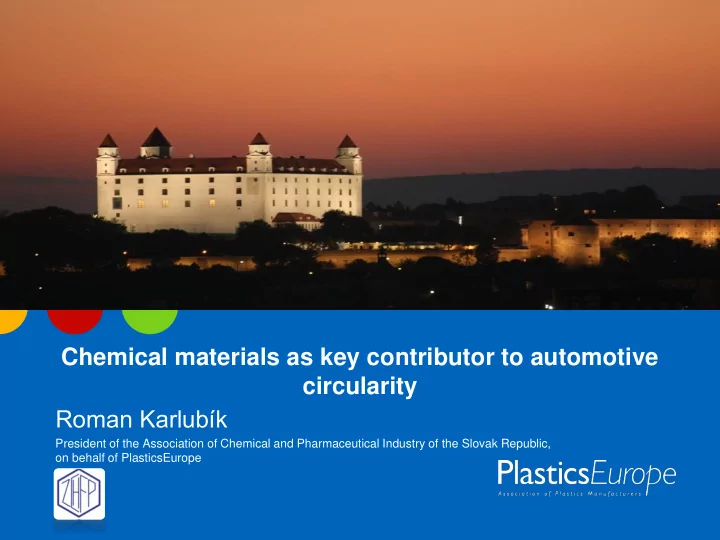

Chemical materials as key contributor to automotive circularity Roman Karlubík President of the Association of Chemical and Pharmaceutical Industry of the Slovak Republic, on behalf of PlasticsEurope
Overview of chemical materials in mobility The chemistry is omnipresent in today's automobile...
...with creative solutions for electromobility
The chemistry in the „E -machine" Insulating hoses Plastic housing Anlaufpilz PTFE Insulating foils PBT PI Polyimid Insulation wire lacquer Bushings Polyimid Slot insulation Para - Aramid Stator insulation Bearing shell Para-Aramid LCP Insulating foils Polyester Insulation sheet metal Bearing shell Polyacetal Insulation impregnants Plastic housing Connectors Polyester Polyamid Inorganic high performance lubricants PTFE
Plastics are a key contributor to innovation in mobility Why use plastics in automotive? Plastics increase safety , for example through airbags Increase durability over vehicle life time Allow ergonomics, driver comfort and styling freedom Allow to take out weight , enabling emissions and fuel reduction, for example through the use of lightweight materials Because they offer tailor-made solutions 5
Plastics are innovative lightweight materials • EU Parliament calls for Weight reduction: • Weight loss is thus critical if CO 2 emissions and the associated fuel costs of a car are to be reduced. • Heavier vehicles = more energy needed Reducing the weight of the bodywork of an average • Plastics save energy and reduce CO 2 emissions car by 100 kg cuts the CO 2 emissions by 10 gr/km • Plastics are crucial for passenger safety • Reducing the effect of vehicle impact on pedestrians, cyclists and other road users • The weight savings of all the plastic parts used thus represent a reduction of 750 liters over the • The drive for lower CO 2 emissions continues to gather 150,000 km life of an average car. These weight momentum in the 21 th century savings also represent a cost reduction for the consumer of approximately 1,000 EUR (at 1.33 • The use of innovative plastics in cars is helping the EUR/liter) automotive industry to cut both costs and emissions Increasing use of lightweight and composite materials
Plastics recovery at the end-of-life • Plastics can also be recovered when a vehicle reaches its end-of life stage, being either recycled, re-used or transformed into energy or fuel, thus helping to meet the EU’s End-of-Life Vehicles Directive • Plastics recovery includes: • Using plastic parts from accident, damaged or end-of-life vehicles to repair cars e.g. head or rear lamps, wash fluid tanks and lids, accessories (such as wings, mats, ashtrays, cup holders, etc.), seats, airbags, dashboards and bumpers • Mechanical recycling: Material reprocessing of end-of-life plastics from Automobile Schredder Residue (ASR) or from automobile parts such as bumpers and battery housings into plastic products • Feedstock recycling: Material reprocessing by chemical means into basic chemicals, monomers for plastics or hydrocarbon feedstock • Energy recovery: use of waste plastics as a means to generate and recover energy Lithium Recycling • R & D project sponsored by BMU: Construction of a pilot plant • Raw material: Separated and pre-treated lithium-containing active materials from EV batteries • Process: • End products: • • High-purity lithium salts Extraction • Transition metal salts or solutions • Purification • Direct re-use of lithium salts • Salt splitting for new battery materials
Development in the Slovak Republic Automotive industry New investments to the R&D in Automotive industry Indicators 2012 2013 2014 2015 2016 Sales revenue (EUR mln) 20 022 21 351 21 228 24 590 25 817 Exports (EUR mln) 15 648 16 764 16 781 19 357 20 969 Value added (EUR mln) 2 266 2 486 2 584 2 911 3 093 Number of employees 60 788 61 181 60 463 65 544 70 175 Connecting industry 2 500 Sales revenue (EUR mln) 2 000 1 500 1 000 500 0 2012 2013 2014 2015 2016 Plastics in primary forms Rubbers products Plastics products Source: Statistical Office of the Slovak Republic
Context of Circular Economy in the Slovak Republic The goals for SVK: • Recycling of 50 % from municipal waste production by 2020 • Reduction of biodegradable waste which are landfilled to 35 % by 2020 Waste package – reduction of landfill to 10 % of waste, which • are produced after recycling or disposal of waste by 2030 The option for SVK: • Application amendment of Coll. 79/2015 – implementing 1.1.2018 • Preparing of new Law on Waste Fees – commenting of the proposals • Consistent separation of municipal and biodegradable waste
Recommend
More recommend